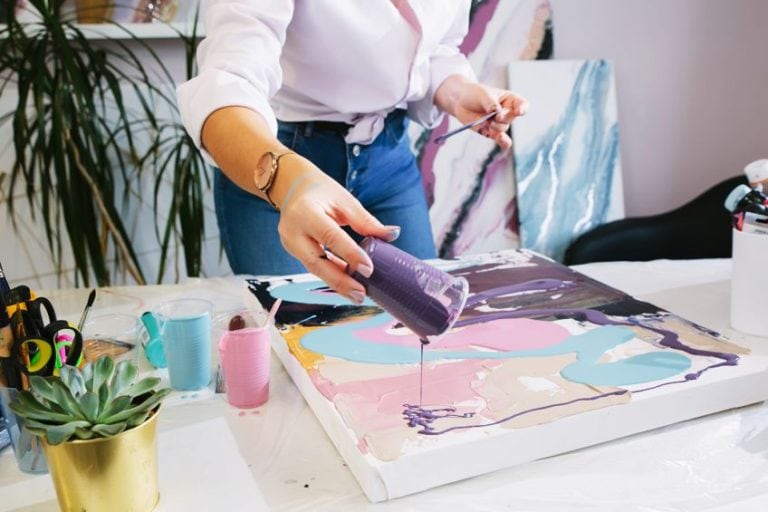How to Make Acrylic Paint – Learn to Make Acrylic Paint at Home
Painting has many benefits, from being something you do just for fun to producing artworks that you can sell. Producing artwork is both therapeutic and rewarding, and many artists take pride in their work and wish to be involved with the entire process. This can sometime mean making their own paints! If you wish to find out how this can be done, read further and learn how to make acrylic paint for your next art project.
Table of Contents
Why Is Acrylic Paint Popular Among Artists?
Acrylic paints are popular because they are safer to use and less toxic, and they are more heat resistant. The paints are also more affordable than many other types of paint. You can easily purchase acrylic paints at the store, but many artists want to get more involved with the whole painting process. Making your own paints can also be a good way to save even more money as you can make more paint than you can get in a tube you purchase.
If you decide to do a bit of DIY acrylic paint, a major benefit is that you are in control of the outcome.
You can determine the amount, color, and texture of the paint. You have full control of what goes into the paint, which means you can avoid any toxic additives, fillers, and other chemicals. Homemade acrylic paint is also more eco-friendly as it reduces the amount of waste that would find itself in landfills.
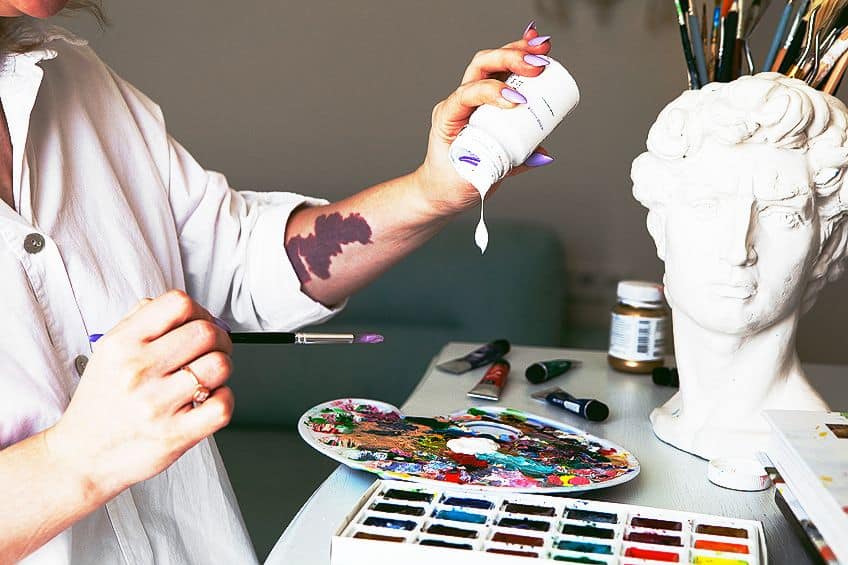
You can also create unique colors, as you can choose what pigments to include. This means you will not be able to find the colors at the art stores, and the paints should last longer than the store-bought varieties. One disadvantage of making your own paints is that it might be difficult to replicate the paint. You will need to make detailed notes and measurements to reproduce a paint color accurately. However, this is a minor challenge if you are determined to make your own acrylic paint.
DIY acrylic paint is ultimately a fun way to be involved in the entire development of creating a beautiful piece of art.
Materials Needed for Making Your Own Paints
When learning how acrylic paint is made, the first step is to find out what the ingredients of acrylic paint are. Making your own paints is not overly complicated and you only need a few things to get started.

- Pigments
- Medium, base, or binder
- Purified water or solvent
- Spatula or palette knife
- Container or surface for mixing
- Mask
- Pipette
You can also include a few other supplies as needed, such as stirring sticks, spoons, measuring cups, and a container or tube to store the paints in. When it comes to the pigments, there are a few you can choose from and include the following.
Organic Pigments
You can get organic pigments from nature, but today most pigments are synthetic organic. These are pigments that are made from carbon compounds and are chemically manufactured and are not something you find in nature. Organic pigments are less toxic than some natural pigments you find in nature. These pigments are also a lot more stable and affordable.
When you work with these pigments, they provide vibrant colors that are effective against light, heat, and solvents. Some examples are as follows:
- Alizarin
- Phthalocyanine
- Quinacridone

Inorganic Pigments
These pigments are of mineral origin and are considered natural. They are also less chemically complex than manufactured organic pigments. Have a look at a few examples of these pigments below.
- Cadmium yellow
- Cobalt blue
- Lead oxide
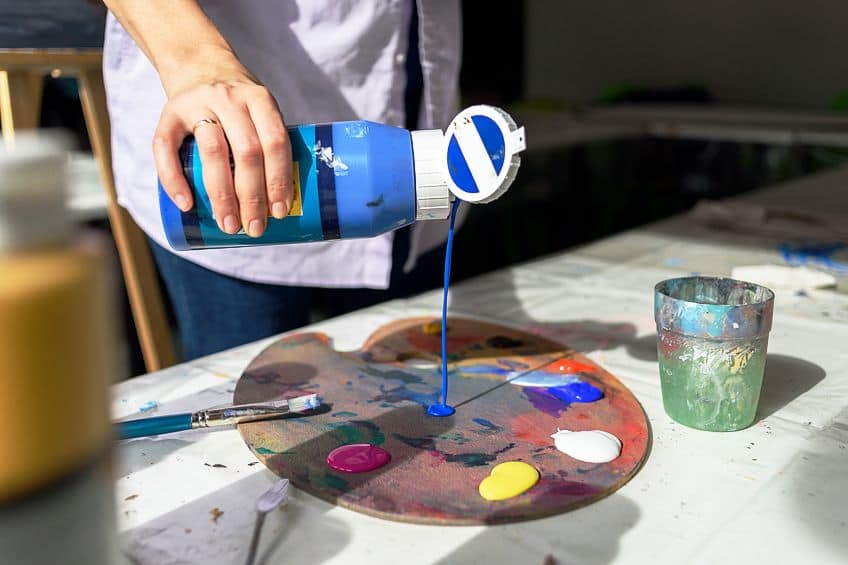
Lake Pigments
This type of pigment is made by combining an organic dye with something known as an inert binder, otherwise known as a mordant. This binder is often a metallic salt. Even though it is a dye, these are still classified as pigments.
The major difference is that they do not work with some binders or thinners. You can get a range of colors in this form.
Acrylic Paint Base
The acrylic paint base or binder forms the base for your paint and pigments, it provides opacity and also determines the flexibility of the final paint product. You can get two main types, which include an acrylic polymer emulsion, which is the more common, and a vinyl acrylic emulsion.
Solvents
A solvent is used to help thin the paint to make it a consistency you can paint with. Whatever you choose should be miscible, meaning it can be mixed with water. If not, and the water and solvent do not mix, it will create an uneven distribution of the paint pigments, which will affect the outcome when painting. There are a few choices, but the most common one is water, or you can try using isopropyl alcohol (IPA) or ethanol. However, these evaporate quickly, and you might need to add more if the paint starts to thicken too much.
One last thing to mention is that when grinding the pigment, it can simply be done using a palette knife.

However, if you are going to be making your own paints often, you should consider getting a glass muller, which acts like a mortar and pestle and does a better job. All of these materials can be purchased at a local art store, but you can also get materials online from places like Amazon and other online art suppliers.
How to Make Acrylic Paint
Let us now look closer and see how acrylic paint is made. Once you have all the materials and ingredients ready and you have decided on a pigment color, you will then need to grind the dry powdered pigment, which can be done using a spatula or palette knife. Grind the pigment until it feels smooth, with no grittiness or bumps. This should be easy to do unless you are using some other form of pigment that does not come in powder form already.
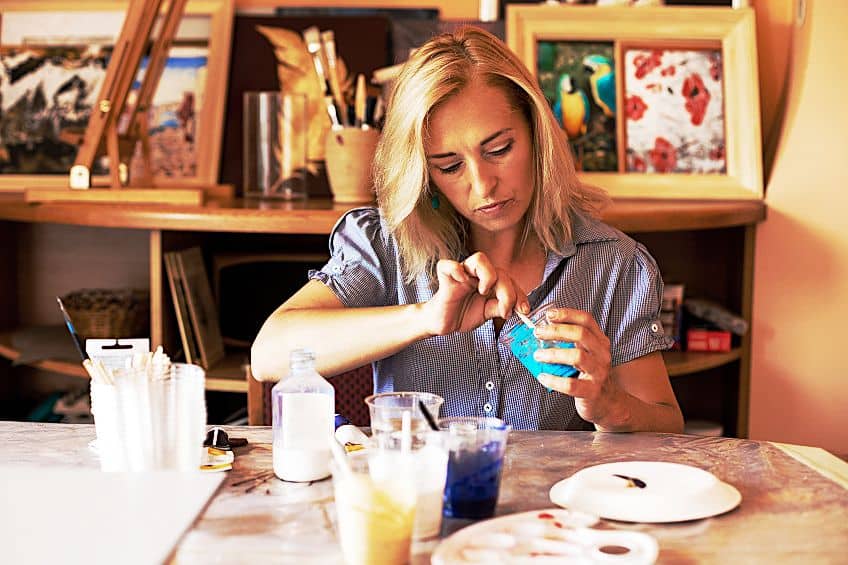
Measuring and Recording
Before mixing any of the ingredients, it is a good idea to measure and then record the amounts of pigment and base you are going to be using. You might need more of the paint color before a painting is done, so you will need to remember how the color was made, and it is best not to leave this up to memory. The recording also helps if you want to consistently make a particular color at any time.
Place the pigment in a mixing container, or you can work on a paint palette or glass surface.
Adding the Acrylic Base
The acrylic paint base does not contain pigment and often comes in a tube you can squeeze. The base comes out quite thick and opaque or white. You can purchase different kinds, such as matte or gloss. Mix the pigment and binder until the pigment is evenly distributed. Read the label on the acrylic base, which should tell you the proper ratio of pigment to binder. This can vary from brand to brand.
Thinning the Paint
Some pigments will float on water, in this case, you can use alcohol to thin the paint. However, the alcohol evaporates quickly, but you can add a little water to the mixture to help with this. Too much alcohol or water can thin the paint too much, so be careful when adding these ingredients.
If it has gone too thin, you can consider adding some acrylic gel thickener.
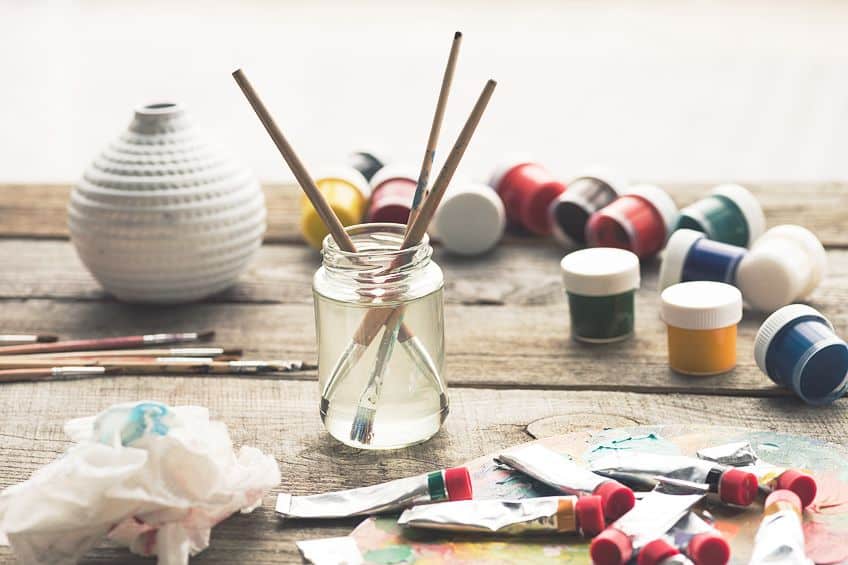
You can try another way to mix and thin the paint. First, place the acrylic binder in the mixing container, and then slowly add water until you have a good consistency. Now add in the pigment, a small amount each time, while mixing thoroughly as you go. Add pigment until you are happy with the color.
How to Use Homemade Acrylic Paint
You can make use of different mediums. Mediums can help to change the properties of the paint, like acrylic gel thickener. You can also consider adding an acrylic retarder, which helps the acrylic paint to dry more slowly. You can experiment with various mediums to see what you can do.
Some artists also include preservatives when making their own paints to help make them last a bit longer.
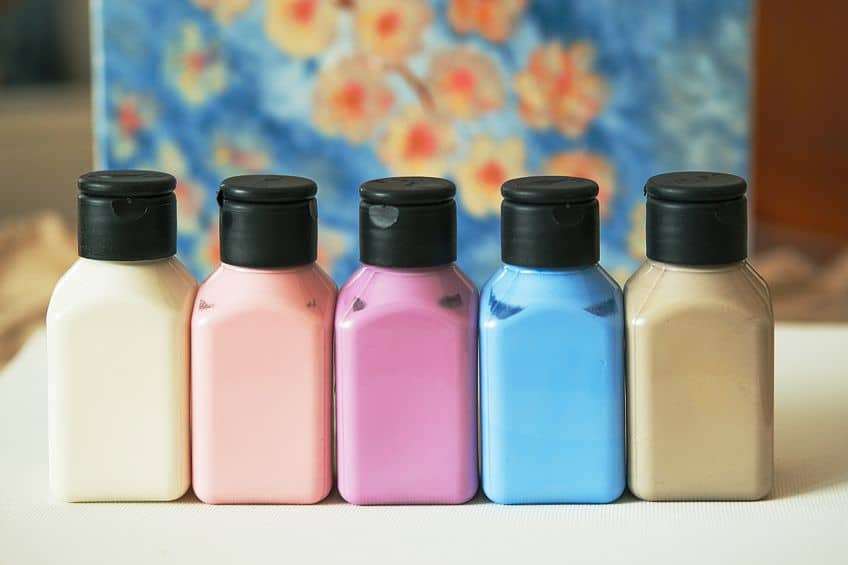
Once you have blended the paint and you are finished painting with it, you need to store the paint properly as acrylic paint does dry quite fast. The paint must be kept in an airtight container. You can empty jam bottles, medicine bottles, or aluminum tubes. The less air you trap inside the container when closing, the better. Always label the container with the color.
DIY Acrylic Paint Safety Precautions
You should follow some safety precautions when dealing with acrylic paints and pigments. Always find out about the pigments you are going to use, to make sure that there are no harmful ingredients as some pigments can be toxic. Have a look at some more paint safety tips.

- Work in a well-ventilated space that is away from other people and animals. This is because you are working with pigment and solvents.
- Once you are done mixing, clean all equipment and wipe surfaces to remove any residue.
- Even though a pigment is non-toxic, the dry pigment can still be breathed in or even ingested. So, make sure to wear a mask.
- Also, you can wear protective eyewear to prevent any pigment particles from irritating the eyes. You can also wear gloves to protect the skin.
- Select the pigments that are the least toxic and avoid carcinogenic or lead-containing pigments.
- Do not mix the pigments in containers or items you use to make food. Also, do not use any utensils you use for food to mix the paints.
- Some artists use preservatives, but even in small amounts, some of these preservatives like formaldehyde can cause an allergic reaction. Also avoid phenol, fluoride, and mercury-containing preservatives.
So, now that you know how to make homemade acrylic paint, you might want to try it out for yourself. Even if you are a beginner, it can be a fun way to learn a bit more about how pigments work, and it might even improve your painting skills!
Frequently Asked Questions
What Are the Main Ingredients of Acrylic Paint?
Acrylic paint can be bought at any store, however, if you are feeling adventurous, you can make your own paint. To do this, you will need three main ingredients, namely pigment, an acrylic binder, and some water or solvent. You can also add various mediums that help produce distinctive effects.
Are Dry Pigments Safe to Use?
You can get natural pigments, but more commonly used pigments today are synthetic. In both cases, some pigments can be toxic, so always make sure before you purchase them. Dry pigments can also be inhaled or ingested and can cause allergic reactions. So, you should be aware of safety precautions when using them.
Can You Include Paint Mediums When Making Your Own Paints?
Yes, you can include any of the paint mediums to help create various effects and textures. There are matte and gloss mediums, as well as texture pastes, glazing mediums, gel mediums, flow improvers, and retarding mediums, amongst others.
In 2005, Charlene completed her Wellness Diplomas in Therapeutic Aromatherapy and Reflexology from the International School of Reflexology and Meridian Therapy. She worked for a company offering corporate wellness programs for a couple of years, before opening up her own therapy practice. It was in 2015 that a friend, who was a digital marketer, asked her to join her company as a content creator, and this is where she found her excitement for writing.
Since joining the content writing world, she has gained a lot of experience over the years writing on a diverse selection of topics, from beauty, health, wellness, travel, and more. Due to various circumstances, she had to close her therapy practice and is now a full-time freelance writer. Being a creative person, she could not pass up the opportunity to contribute to the Art in Context team, where is was in her element, writing about a variety of art and craft topics. Contributing articles for over three years now, her knowledge in this area has grown, and she has gotten to explore her creativity and improve her research and writing skills.
Charlene Lewis has been working for artincontext.org since the relaunch in 2020. She is an experienced writer and mainly focuses on the topics of color theory, painting and drawing.
Learn more about Charlene Lewis and the Art in Context Team.
Cite this Article
Charlene, Lewis, “How to Make Acrylic Paint – Learn to Make Acrylic Paint at Home.” Art in Context. May 22, 2023. URL: https://artincontext.org/how-to-make-acrylic-paint/
Lewis, C. (2023, 22 May). How to Make Acrylic Paint – Learn to Make Acrylic Paint at Home. Art in Context. https://artincontext.org/how-to-make-acrylic-paint/
Lewis, Charlene. “How to Make Acrylic Paint – Learn to Make Acrylic Paint at Home.” Art in Context, May 22, 2023. https://artincontext.org/how-to-make-acrylic-paint/.




